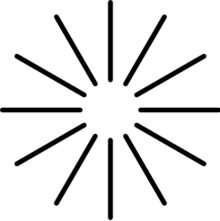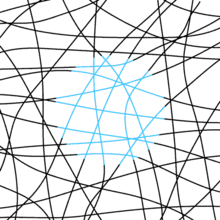20:
171:
41:
that evoke the perception of an edge without a luminance or color change across that edge. Illusory brightness and depth ordering often accompany illusory contours. Friedrich
Schumann is often credited with the discovery of illusory contours around the beginning of the 20th century, but they are
78:
Typically, the shape seems brighter than the background, even though the luminance is in reality homogeneous. Additionally, the illusory shape seem to be closer to the viewer than the inducers. Kanizsa figures involve modal completion of the illusory shape and amodal completion of the inducers.
94:
189:'s innate mechanisms for interpreting the visual world under normal conditions. For example, objects in the natural world are often only partially visible. Illusory contours provide clues for how the visual system constructs surfaces when portions of the surface's
196:
The encoding of surfaces is thought to be an indispensable part of visual perception, forming a critical intermediate stage of visual processing between the initial analysis of visual features and the ability to recognize complex stimuli like
105:. Instead of employing Pac-Man inducers, the Ehrenstein illusion triggers an illusory contour percept via radial line segments. Ehrenstein's discovery was originally contextualized as a modification of the Hermann grid.
70:
Kanizsa figures trigger the percept of an illusory contour by aligning Pac-Man-shaped inducers in the visual field such that the edges form a shape. Although not explicitly part of the image, Kanizsa figures evoke the
544:
Phenomena of contour, color and movement perception have been used to identify functions of neurons and to reveal functional differences between cortical areas that application of classical
113:
Illusory contours are created at the boundary between two misaligned gratings. In these so-called abutting line gratings, the illusory contour is perpendicular to the inducing elements.
26:: These spatially separate fragments give the impression of a bright white triangle, defined by a sharp illusory contour, occluding three black circles and a black-outlined triangle.
255:
Schumann, F (1900), "Beiträge zur
Analyse der Gesichtswahrnehmungen. Erste Abhandlung. Einige Beobachtungen über die Zusammenfassung von Gesichtseindrücken zu Einheiten.",
298:
Ehrenstein, W (1941), "Über
Abwandlungen der L. Hermannschen Helligkeitserscheinung (Modifications of the Brightness Phenomenon of L. Hermann).",
155:
510:
Peterhans, E.; von der Heydt, R. (1991). "Subjective contours--bridging the gap between psychophysics and physiology".
447:
353:
von der Heydt, R; Peterhans, E; Baumgartner, G (1984), "Illusory contours and cortical neuron responses",
576:
220:
486:
225:
389:"Selective Activation of the Deep Layers of the Human Primary Visual Cortex by Top-Down Feedback"
560:
481:
387:
Kok, Peter; Bains, Lauren; van Mourik, Tim; Norris, David G.; de Lange, Floris (2016-02-08).
131:
448:"Visual surface representation: a critical link between lower-level and higher level vision"
174:
8:
102:
88:
581:
535:
527:
523:
499:
428:
420:
370:
336:
331:
205:
182:
539:
50:
paper marked the resurgence of interest in illusory contours for vision scientists.
519:
491:
410:
400:
362:
326:
279:
Kanizsa, G (1955), "Margini quasi-percettivi in campi con stimolazione omogenea.",
198:
134:
often used the
Kanizsa illusion in his silkscreen prints, for instance in his work
38:
545:
235:
159:
125:
43:
147:
230:
210:
190:
405:
388:
570:
424:
186:
151:
124:
logos from 1972, 1984, 1988, and 1994 all feature illusory contours, as does
121:
366:
317:
Soriano, M; Spillmann, L; Bach, M (1996), "The abutting grating illusion.",
432:
531:
503:
374:
340:
415:
215:
72:
158:
have found that illusory contours are associated with activity in the
495:
181:
Visual illusions are useful stimuli for studying the neural basis of
170:
154:
are responsible for forming illusory contours. Studies using human
19:
93:
352:
64:
509:
63:
Perhaps the most famous example of an illusory contour is the
257:
Zeitschrift für
Psychologie und Physiologie der Sinnesorgane
472:
Coren, S (1972), "Subjective contour and apparent depth",
146:
It is thought that early visual cortical regions such as
386:
455:
An
Invitation to Cognitive Science: Visual cognition
316:
53:
445:
274:
272:
270:
75:of a shape, defined by a sharp illusory contour.
568:
267:
67:configuration popularized by Gaetano Kanizsa.
116:
165:
97:The Ehrenstein illusion is of a bright disc
297:
101:Closely related to Kanizsa figures is the
42:present in art dating to the Middle Ages.
485:
414:
404:
330:
177:: the cyan circle's contours are illusory
108:
254:
169:
92:
18:
446:Nakayama, K; He, Z; Shimojo, S (1995).
278:
569:
82:
471:
141:
13:
465:
58:
14:
593:
554:
54:Common types of illusory contours
563:Many unpublished drawings (fr)
439:
380:
346:
310:
291:
248:
1:
457:. Vol. 2. pp. 1–70.
241:
221:Gestalt psychology: 'closure'
524:10.1016/0166-2236(91)90072-3
332:10.1016/0042-6989(95)00107-b
7:
548:concepts has not suggested.
300:Zeitschrift für Psychologie
10:
598:
162:of primary visual cortex.
86:
561:Illusory contours figures
406:10.1016/j.cub.2015.12.038
117:In art and graphic design
185:because they hijack the
166:Related visual phenomena
367:10.1126/science.6539501
156:neuroimaging techniques
178:
109:Abutting line gratings
98:
27:
281:Rivista di Psicologia
226:Gestalt 'reification'
173:
132:Jacob Gestman Geradts
96:
22:
474:Psychological Review
175:Neon color spreading
361:(4654): 1260–1262,
103:Ehrenstein illusion
89:Ehrenstein illusion
83:Ehrenstein illusion
48:Scientific American
35:subjective contours
179:
142:Cortical responses
99:
28:
24:Kanizsa's triangle
577:Optical illusions
206:Amodal perception
193:are not visible.
128:'s 1950s series.
31:Illusory contours
589:
550:
506:
496:10.1037/h0032940
489:
459:
458:
452:
443:
437:
436:
418:
408:
384:
378:
377:
350:
344:
343:
334:
314:
308:
307:
295:
289:
288:
276:
265:
264:
252:
39:visual illusions
16:Visual illusions
597:
596:
592:
591:
590:
588:
587:
586:
567:
566:
557:
546:receptive-field
512:Trends Neurosci
487:10.1.1.278.7980
468:
466:Further reading
463:
462:
450:
444:
440:
393:Current Biology
385:
381:
351:
347:
315:
311:
296:
292:
277:
268:
253:
249:
244:
236:Phantom contour
168:
144:
126:Ellsworth Kelly
119:
111:
91:
85:
61:
59:Kanizsa figures
56:
44:Gaetano Kanizsa
17:
12:
11:
5:
595:
585:
584:
579:
565:
564:
556:
555:External links
553:
552:
551:
518:(3): 112–119.
507:
480:(4): 359–367,
467:
464:
461:
460:
438:
399:(3): 371–376.
379:
345:
325:(1): 109–116,
309:
290:
266:
246:
245:
243:
240:
239:
238:
233:
231:Negative space
228:
223:
218:
213:
211:Autostereogram
208:
167:
164:
143:
140:
118:
115:
110:
107:
87:Main article:
84:
81:
60:
57:
55:
52:
15:
9:
6:
4:
3:
2:
594:
583:
580:
578:
575:
574:
572:
562:
559:
558:
549:
547:
541:
537:
533:
529:
525:
521:
517:
513:
508:
505:
501:
497:
493:
488:
483:
479:
475:
470:
469:
456:
449:
442:
434:
430:
426:
422:
417:
412:
407:
402:
398:
394:
390:
383:
376:
372:
368:
364:
360:
356:
349:
342:
338:
333:
328:
324:
320:
313:
305:
301:
294:
286:
282:
275:
273:
271:
262:
258:
251:
247:
237:
234:
232:
229:
227:
224:
222:
219:
217:
214:
212:
209:
207:
204:
203:
202:
200:
194:
192:
188:
187:visual system
184:
176:
172:
163:
161:
157:
153:
152:visual system
149:
139:
137:
133:
129:
127:
123:
114:
106:
104:
95:
90:
80:
76:
74:
68:
66:
51:
49:
45:
40:
36:
32:
25:
21:
543:
515:
511:
477:
473:
454:
441:
396:
392:
382:
358:
354:
348:
322:
318:
312:
303:
299:
293:
284:
280:
260:
256:
250:
201:and scenes.
195:
180:
145:
135:
130:
120:
112:
100:
77:
69:
62:
47:
34:
30:
29:
23:
416:2066/155736
319:Vision Res.
160:deep layers
571:Categories
242:References
216:Filling-in
183:perception
73:Perception
582:Triangles
482:CiteSeerX
425:0960-9822
287:(1): 7–30
136:Formula 1
540:11553954
433:26832438
138:(1991).
46:’s 1976
532:1709535
504:5038153
375:6539501
355:Science
341:8746248
306:: 83–91
150:in the
122:Olympic
65:Pac-Man
538:
530:
502:
484:
431:
423:
373:
339:
263:: 1–32
536:S2CID
451:(PDF)
199:faces
148:V1 V2
528:PMID
500:PMID
429:PMID
421:ISSN
371:PMID
337:PMID
191:edge
37:are
520:doi
492:doi
411:hdl
401:doi
363:doi
359:224
327:doi
304:150
33:or
573::
542:.
534:.
526:.
516:14
514:.
498:,
490:,
478:79
476:,
453:.
427:.
419:.
409:.
397:26
395:.
391:.
369:,
357:,
335:,
323:36
321:,
302:,
285:49
283:,
269:^
261:23
259:,
522::
494::
435:.
413::
403::
365::
329::
Text is available under the Creative Commons Attribution-ShareAlike License. Additional terms may apply.


